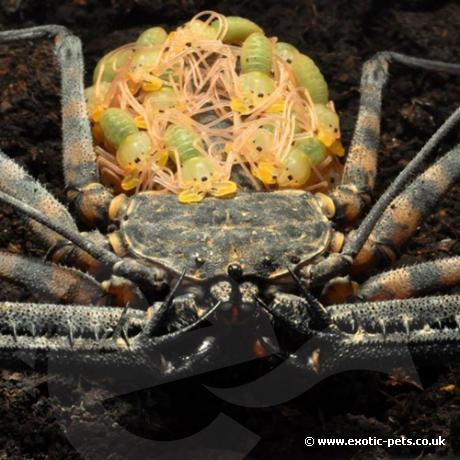

These have to be one of the strangest invertebrates out there! They look like a cross between a spider, scorpion and crab. These nocturnal creatures are very exciting to own and watch.
These strange and weird looking creatures look like a cross between a spider, scorpion and crab. They belong to an order of arachnids called the Amblypygi (Pronounced: am-bli-pie-gee), which is grouped alongside the True spiders (Araneae) and the Whip Scorpions (Uropygi).
Amblypygids look similar to many spider species, but possess very long modified front legs (often up to 4x the length of the body) that act as feelers to detect vibrations, prey items, obstacles etc. They also have large raptorial pedipalps (these are the things that look like large claws) to capture and hold prey items, males being longer then the females. They do not spin silk and rely on active hunting using their huge claws in order to capture prey.
They tend to reach around 50- 70mm (2- 3") in body size and are of a mottled brown/black/cream colouration.
Commonly offered species include Damon variegatus, Damon diadema and Damon medius found throughout Western, Central, Eastern and Southern Africa.
These arachnids tend to be nocturnal, and move around in a side-ways fashion similar to crabs. In order to house them naturally, a fairly large container should be used, which has a large vertical surface on which it can move around in. A 12" x 12" x 12" (l x h x d) or larger tank should be used to hold one adult Amblypygid. Adults of the same size can be kept together provided a large container is used and it's a good idea to increase the feeding regime as well if multiple individuals are to be kept in the same container.
Use of a hard stone background (eg limestone) is not recommended as this actually wears out the claws on the feet of adult Amblypygids, and can kill them during moults are they fall off onto the substrate. A polystyrene or soft bark wall is ideal.
Substrate can be a mix of coir block, sphagnum moss and chemical-free composts. Amblypygids tend not to move around much on the substrate (they are very timid if they do venture onto it), so a depth of around 2" is sufficient to trap moisture and maintain humidity. A water dish should be provided, as Amblypygids will occasionally drink.
Provide a temperature of 24-26C during the day and allow a slight drop at night (20-24C). Some other species require cooler conditions, but these are not often offered for sale at present and the general conditions above should be suitable for most Amblypygids.
Humidity of around 80% is usually sufficient for adults, with an increase for newly hatched individuals and juveniles. Unlike many beginner tarantulas, many Amblypygids require high humidity and sufficient air movement otherwise they often become sickly if confined in such a manner for more than a few weeks. An easy way to avoid this is to make numerous small holes on the sides of the container to allow free passage of air through the container.
Amblypygids are not renowned for being large eaters, so a few large adult crickets or similar per fortnight would be a good starting point for a feeding regime for adult specimens. Any that appear very fat, especially with dark green or bluish tints are likely to be approaching a moult and food should be withheld.